
It starts quietly. A room. A conversation. You sit down and begin explaining what you’ve noticed. You speak about your hairline, but what you’re really talking about is memory. The version of you that used to feel complete. You point to photos. To mirrors. You say, “I don’t need perfection. I just want to feel like me again.” The surgeon listens with focus, but not judgment. They nod slowly. They ask how long this has been bothering you. You realize you’ve carried this more quietly than you thought.
This is the first step—being heard.
A hairline isn’t drawn—it’s understood
You expect a template. A sketch. But what happens is more intimate than that. The surgeon doesn’t just map your head. They study your face. Your bone structure. Your age. Your future. They ask where you want to see growth, not where others expect it. They design something subtle. Something believable. Something soft. It’s not about youth. It’s about balance. Harmony. You don’t leave with numbers. You leave with a plan.
And for the first time in a long time, the mirror feels like possibility.
The result isn’t dramatic—it’s believable
This isn’t about drastic change. It’s about restoration. Something that makes sense with who you are. Something that will grow with you—not against time, but within it. You won’t walk out with a new face. You’ll walk out with your own, just… more settled. More present. It’s not shock value. It’s quiet recognition. And that’s what makes it powerful.
Subtlety is sometimes the deepest kind of transformation.
You don’t feel pain—you feel presence
On the day of the procedure, you show up early. Nervous, maybe. But ready. You’re greeted with calm. The team is gentle, focused, unhurried. They walk you through everything again, just to make sure. Then, the anesthesia. Slow. Careful. You don’t feel pain. You feel hands. Movement. Light touches. You close your eyes. There’s music playing softly in the background. And somehow, you begin to trust.
Not because it’s painless, but because it’s personal.
Every follicle is a seed. Every seed has a future
The extraction begins. One graft at a time. Tiny, delicate units of hair—removed with care. The donor area gives without trauma. Your own hair, your own biology, reused with precision. Each graft is stored gently. Counted. Protected. These are not numbers—they are potential. Every follicle carries not just growth, but intention. You imagine them taking root. Quietly, beneath the surface.
Like planting something you’ll see bloom in seasons, not seconds.
They imagine your next decade—and build it strand by strand
Now comes placement. Where design becomes art. Each graft is placed with angle, depth, direction. The surgeon doesn’t just insert hair. They restore pattern. Flow. Life. They think about how your hair moves when wet. When messy. When untouched. They think about what it will look like in five years. And they create that version now, with tools finer than thread and vision deeper than technique.
What they build is not just appearance—it’s continuity.
You feel pressure—not pain
The hours stretch. You rest. Sometimes you drift. Sometimes you listen. The rhythm becomes soft. Hands moving. Grafts placed. Breaks taken. There’s food, water, kindness. You’re checked on constantly. You don’t feel the hours passing. You just feel something unfolding. You think about the version of you who started this. And you realize, you already feel closer to them.
Because doing something about it is its own kind of healing.
The grafts are fragile at first—but strong underneath
You go home that day. Tender. Wrapped. Carefully instructed. You lie on your back when sleeping. You use special sprays. You don’t touch the area unless told. The grafts look tiny, but you know what they hold. In the mirror, they look vulnerable. But you’ve never seen something so small feel so hopeful. The skin reddens. Scabs form. You follow the rules. You protect them like they’re still part of you—because they are.
And like all new beginnings, they require patience.
Not because you changed—because you returned
Weeks go by. Some of the transplanted hair falls out. You knew it would. Still, it stings. But you remember—they told you this. Shedding is part of the story. Underneath, the new follicles are already alive. Already waking. Months pass. Then, suddenly—you see something. A glint in the mirror. A soft line. New growth. It catches you off guard. And then again. And again. Until it’s not new anymore. It’s just you.
Not improved. Not fixed. Just… remembered.
You forget to overthink the wind
You stop styling so carefully. You leave the house without checking your angles. You feel the breeze and don’t wince. You let your hair be hair—free, imperfect, moving. You touch your scalp without overthinking. You take photos without tilting. You start recognizing yourself in shadows again. Not because everything is perfect—but because nothing feels missing.
